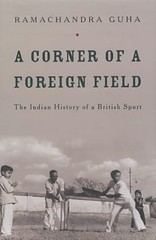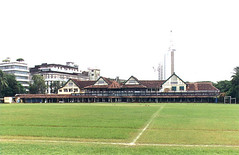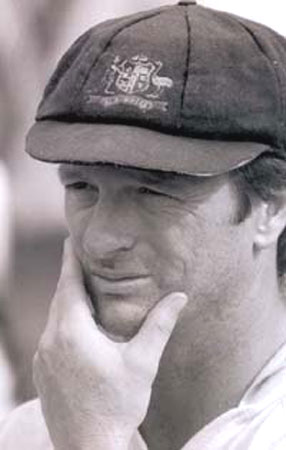It was a decade later that I got to read Beyond a Boundary and promptly concurred with John Arlott's crowning the book as a magnum opus - a lovely odyssey through James' love of Thackeray, Byron and Shakespeare besides cricket, his consuming passion. In the later half of his life, James moves to London and with the stalwart Learie Constantine seeks support for West Indian self-government like our own Subash Chandra Bose. It was a fascinating oeuvre of a sports lover's parallel passion for cricket and nationalism.
 Early this summer a knowledgeable pal of mine recommended Ramachandra Guha's A Corner of a Foreign Field and it was a enjoyable read as well. History is sure to place this book a special place in cricket history. More importantly it will be of special interest to the select few(who really care) among the millions of Indian masses addicted to the game.
Early this summer a knowledgeable pal of mine recommended Ramachandra Guha's A Corner of a Foreign Field and it was a enjoyable read as well. History is sure to place this book a special place in cricket history. More importantly it will be of special interest to the select few(who really care) among the millions of Indian masses addicted to the game.
Without further ado, we will run through the pulsating first half of the book - The infantile days of Indian cricket and the underpinnings of colonialism, caste, religion and bureaucracy that accompanied it all through its existence.
It was GM Trevelyan the Cambridge historian who quipped that had the French nobles played cricket with the peasants, the fall of the Bastille could have been averted! The reference is obviously to the origin of the game in India and the colonial context in its early stages. The game which is now a religion was first practiced by British army officers to recreate memories of English life in the dusty subcontinent. For this was a game that oozed "Britishness" in every sense. An escapism for the Englishmen to forget the randomness of Indian life. More importantly, it was a tool to obscure distinctions of property and class - to bind the native firmly to the colonizer, especially if the latter was a player of skill and merit.
The earliest cricket clubs were set up in the main Indian cities in the mid-1800s. English games such as whist, billiards, tennis, and cricket were patronized at the Madras Cricket Club and the Calcutta Cricket Club. It was an occasion for the socialites rounded off with English food. Needless to say, entry was restricted to the Europeans. As far as the native Indians went, ground leveling and pitch preparation were the only tasks expected of them.
Test matches between Australia and England began in 1877. By then the Bombay Gymkhana had been started by the British (1875) near Azad Maidan and boasted a picturesque cricket ground where only the Europeans were allowed. The very first natives to develop a love for cricket were the Parsees. Trade and commerce being occupations typically shunned by the caste Hindus, the Parsees were a thriving and well-educated minority on the commercial front. While the Hindu was clad in dhoti and cap, the Parsee wasted no time in taking to western dress, music or language. Cricket proved to be no exception replacing gilli-danda his traditional sport. The first cricket clubs were sponsored by the Tatas and the Wadias. Similarly businessmen such as Venkataswamy Naidu(Parry's) and Buchibabu were instrumental in setting up the Madras United Cricket Club, the answer to the whites-only Madras Cricket Club.
 Whereas the Englishman enjoyed access to the Bombay Gymkhana ground(pic at left), thousands of locals were consigned to the Maidan(near the Victoria Terminus). In 1879, British Army officers used the locals' maidan for playing polo twice a week. The divots of the horses made a complete mess of the turf where the Indians practiced. It was the firebrand lawyer Shapoorji Sorabjee(any relation to Soli?) who waged a battle with the British powers requesting them to stop their officers from using their maidan for polo. The protests fell on deaf ears, despite Dadabhai Naoroji joining Sorabjee in his campaign by 1882. Two years later, the Parsees temporarily had their turf to themselves before the encroaching resumed.
Whereas the Englishman enjoyed access to the Bombay Gymkhana ground(pic at left), thousands of locals were consigned to the Maidan(near the Victoria Terminus). In 1879, British Army officers used the locals' maidan for playing polo twice a week. The divots of the horses made a complete mess of the turf where the Indians practiced. It was the firebrand lawyer Shapoorji Sorabjee(any relation to Soli?) who waged a battle with the British powers requesting them to stop their officers from using their maidan for polo. The protests fell on deaf ears, despite Dadabhai Naoroji joining Sorabjee in his campaign by 1882. Two years later, the Parsees temporarily had their turf to themselves before the encroaching resumed.In 1885, the Indian National Congress had been formed. By now, Lord Harris an ex-captain of England, Kent and Oxford University arrived in India. Every inch an English royal, Harris was born in the other famous English colony, the West Indies. His grandfather was one of the generals who had defeated Tippu Sultan. Sorabjee renewed his appeal for sovereign rights to the Maidan, appealing to Harris' experience as a cricketer himself (being the second man to lead an England team). Upon which the wily British ruler called upon the Parsees to exhibit a "spirit of generous concession" that the gentleman's game teaches, and with all meekness, accommodate the incursion of the Polo players!
Naoroji was elected to the British Parliament in 1892. While Harris officially congratulated the Parsee attorney, he wrote a letter to his Secretary of State expressing disgust at the election of an Indian to the House. In 1892-93, Bombay was rocked by communal riots taking a good number of casualties. Harris was then basking in a hill station in Poona, returning only the 9th day after the riots to Bombay and that to witness a cricket match! He boasted to Lord Wenlock the Madras Governor that the year had seen 5399 bottles of liquor consumed in his residence.
Cricket had well and truly permeated the consciousness of the natives. In addition to the little clubs patronized by businessmen from Lahore to Madras, the Aligarh Muslim University had a number of enthusiasts, the game being introduced by one of the local brahmin teachers in the institution. Shaukat Ali the university captain had become as famous as his nationalist brother, Maulana Mohammed. By 1892-83, the Parsees had played 2 games against an English team, winning both - masterminded by Dr.Pavri, the Grace of the Parsees. Led by Framji Patel the businessman-cricketer, they also possessed BC Machliwallah the Parsee Jessop. Pavri and Patel were fine gentlemen in addition to their undoubted skill in cricket. In 1892, the incursion of polo was quelled and the government gave away sufficient land for the 3 major communities to set up their own gymkhanas.
While cricket was predominantly a Parsee stronghold among the natives, one local did catch the eye abroad. Kumar Shri Ranjitsinhji the Rajkumar of Nawanagar went to Cambridge in 1891. His spectacular batting talent wasn't enough for he had to wait till 1893 to earn his Blue against Oxford. He got a chance to play for Sussex in the 1894-95 seasons and had become a strong contender for the England team for the 1895 Ashes. Our now-familiar villain Lord Harris steps in once again, this time as the President of the MCC. Harris opposed Ranji's selection tooth and nail, pressing a rule forbidding non-natives to play for England. A more blatant example of hypocrisy there never was, for Harris himself had been born in Trinidad! The Indian was successfully kept out for the Lord's Test, the ground being the bastion of the MCC. He debuted in the next Test at Manchester starting with a sparkling 62. The second innings was even better showcased the batting wizard in all his pomp - 154 not out exquisitely made runs. There was no stopping Ranji as he went on to tour Australia in the 1897 Ashes, beginning in style with 175 in the Sydney Test and finishing with 457 runs overall. Neville Cardus described the Oriental genius as "A Midsummer Night's dream".
But while Ranji was the first noteworthy cricketer of Indian origin, he was a staunch British loyalist! He wrote a historical treatise on English cricket and dedicated it to the Queen. Though not as pampered and philanderous like the other Indian princes, he was nevertheless a Prince and therefore more concerned about his wealth and property while the natives fought for freedom. Ranji would occasionally visit India for the purpose of staking his claim as the heir, as he had to compete with the son of one of his father's concubines. His ambitions required him to be on good terms with the English rulers.
(A word needs to be added about the Indian Maharajahs, for whom wine, women and hunting were the essential features of existence. Like classical music, cricket would not have survived the 20th century if not for their patronage. The Maharajas often captained sides as a token of gratitude for their donations. The monarch would be carried out by his attendants when his turn came to bat. Reaching the crease in stately grandeur, he would be fed a generous dose of full-tosses and half-volleys by the already-bribed bowler. In a short while, he would leave the field after reaching the inevitable 100! There's this story of a Raja who asked Ranji at a school function if he had ever made a duck - the latter answered 'Several times' to which the former proudly claimed he never made one all his career. A startled Ranji promptly declared a holiday for the schoolboys!)
We go back to the local scene now. The Parsees were very much on top of the cricketing hierarchy, making bold to challenge the Europeans. There was a wide gulf between them and their rivals at commerce, the Hindus(For one thing, some of the Hindus would be seen in maidans bowling with their dhoti and traditional wear!).
In the next few years Hindu Gymkhana found the man to redeem their pride and prestige. And a most unlikely and unexpected one at that.
You made me recall Gardiner's All About a Dog and On the Rule of The Road from schooldays.
While Gardiner was effusive in praise, AS De Mello was scathing on Ranji doing nothing for the natives.
AFST was a truly remarkable man - the Sivaji Ganesan among commentators. It's a pity there's no clipping of his voice available.
ROTFL @ your allusion to Hamlet!! :-)))
Was Ananda Rao the guy who bored listeners for 15 minutes about the greatness of Pongal during a Chepauk game and then said "Meanwhile, Prasanna has triggered a collapse taking 3 quick wickets!" ?? :)
idhellaam over..syllabus thedarathey exam-ku munaadi naal thaane? ;)
i,
enna solla vare-nu onnume purile :(
<< Home


